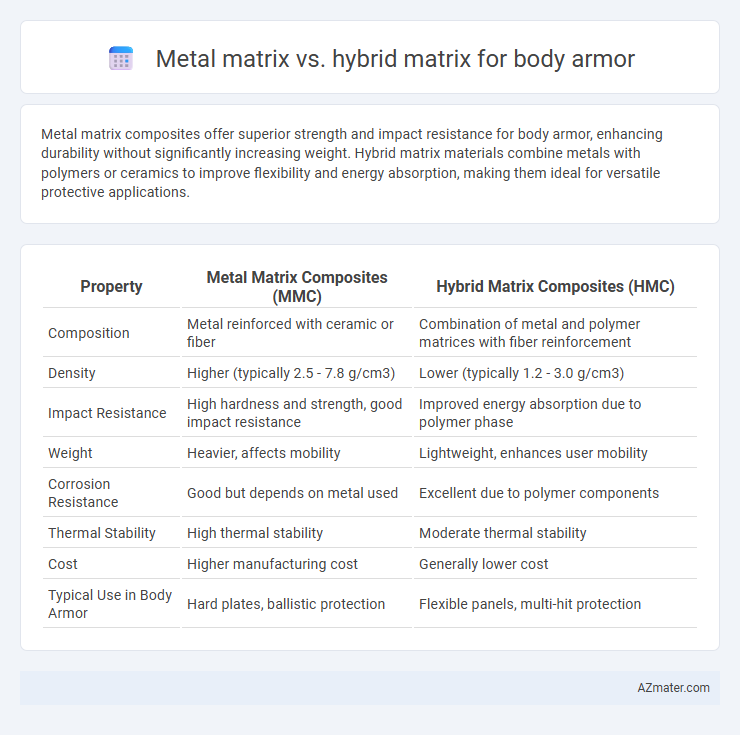Metal matrix composites offer superior strength and impact resistance for body armor, enhancing durability without significantly increasing weight. Hybrid matrix materials combine metals with polymers or ceramics to improve flexibility and energy absorption, making them ideal for versatile protective applications.
Table of Comparison
| Property | Metal Matrix Composites (MMC) | Hybrid Matrix Composites (HMC) |
|---|---|---|
| Composition | Metal reinforced with ceramic or fiber | Combination of metal and polymer matrices with fiber reinforcement |
| Density | Higher (typically 2.5 - 7.8 g/cm3) | Lower (typically 1.2 - 3.0 g/cm3) |
| Impact Resistance | High hardness and strength, good impact resistance | Improved energy absorption due to polymer phase |
| Weight | Heavier, affects mobility | Lightweight, enhances user mobility |
| Corrosion Resistance | Good but depends on metal used | Excellent due to polymer components |
| Thermal Stability | High thermal stability | Moderate thermal stability |
| Cost | Higher manufacturing cost | Generally lower cost |
| Typical Use in Body Armor | Hard plates, ballistic protection | Flexible panels, multi-hit protection |
Introduction to Body Armor Material Technology
Metal matrix composites in body armor offer high strength-to-weight ratios and excellent ballistic resistance due to their dense, rigid structure combined with metal ductility. Hybrid matrix materials integrate multiple phases, such as ceramics combined with polymers or metals, to optimize energy absorption and reduce overall armor weight while enhancing multi-impact performance. Innovations in these materials focus on balancing protection, flexibility, and thermal stability to improve soldier mobility and survivability in combat scenarios.
Overview of Metal Matrix Composites (MMC)
Metal Matrix Composites (MMCs) combine metal matrices such as aluminum, titanium, or magnesium with reinforcement materials like ceramic fibers or particles to enhance mechanical properties, including strength, hardness, and thermal stability. In body armor applications, MMCs offer superior ballistic resistance, lightweight characteristics, and improved energy absorption compared to traditional metal plates. Their tailored microstructure enables optimized performance under high-impact conditions, making MMCs a critical advancement over pure metal or hybrid matrix armor systems.
Hybrid Matrix Composites: Definition and Types
Hybrid matrix composites for body armor combine two or more distinct matrix materials, such as metal and polymer, to enhance overall performance by leveraging the strengths of each. Common types include metal-polymer hybrids, which provide improved impact resistance and energy absorption, and ceramic-metal hybrids, offering superior hardness and toughness for ballistic protection. These composites enable tailored material properties, optimizing weight, durability, and resistance critical for advanced protective gear.
Structural Differences: Metal Matrix vs Hybrid Matrix
Metal matrix composites for body armor primarily consist of a metal base, such as aluminum or titanium, reinforced with ceramic particles or fibers, providing high strength and excellent impact resistance. Hybrid matrices combine metal and polymer components, integrating the toughness and energy absorption of metals with the lightweight flexibility and damping properties of polymers. Structural differences between these matrices influence performance characteristics, with metal matrices offering superior hardness and thermal resistance, while hybrid matrices enhance overall resilience and reduce weight for improved wearer mobility.
Comparative Ballistic Performance
Metal matrix composites exhibit superior ballistic performance in body armor due to their high hardness and energy absorption capabilities, effectively dispersing kinetic energy from projectiles. Hybrid matrix systems, combining metal with polymer or ceramic phases, enhance toughness and reduce weight while maintaining adequate impact resistance, offering improved multi-hit performance. Comparative tests reveal metal matrices excel in penetration resistance, whereas hybrid matrices provide a balanced solution between durability and wearer mobility under ballistic stress.
Weight and Flexibility Considerations
Metal matrix composites in body armor offer superior impact resistance but tend to be heavier and less flexible, impacting overall wearer mobility. Hybrid matrix composites combine metal with polymers or ceramics, significantly reducing weight while enhancing flexibility and comfort without compromising protection levels. Weight optimization and flexibility improvements in hybrid matrices contribute to improved soldier endurance and agility in dynamic combat environments.
Durability and Wear Resistance
Metal matrix composites (MMCs) used in body armor offer exceptional durability due to their high strength-to-weight ratio and resistance to deformation under impact. Hybrid matrix composites combine metal matrices with ceramic or polymer reinforcements, enhancing wear resistance by reducing abrasion and surface degradation during multiple ballistic impacts. The integration of hybrid matrices results in superior longevity and sustained protective performance compared to traditional metal matrix armor solutions.
Cost and Manufacturing Complexity
Metal matrix composites for body armor exhibit higher manufacturing complexity due to processes like powder metallurgy and infiltration, which drive up production costs. Hybrid matrix composites, integrating polymers with ceramic or metallic reinforcements, leverage lower-cost materials and simpler fabrication methods such as resin transfer molding, reducing overall expenses. Cost-efficiency in hybrid matrix body armor arises from scalable manufacturing techniques and the use of versatile, less energy-intensive materials compared to metal matrix alternatives.
Field Applications and User Feedback
Metal matrix composites (MMCs) in body armor provide superior ballistic resistance and thermal stability, making them ideal for military and law enforcement personnel engaged in high-threat environments. Hybrid matrix armors combining metals with ceramics or polymers offer enhanced flexibility and weight reduction, resulting in improved user mobility and comfort during extended field operations. Field feedback highlights MMCs' durability under impact, while hybrid matrices receive praise for balancing protection with ease of wear, crucial for dynamic combat scenarios.
Future Trends in Body Armor Materials
Future trends in body armor materials emphasize the development of hybrid matrix composites combining metal matrices like aluminum or titanium with ceramic or polymer reinforcements to enhance ballistic performance and reduce weight. Innovations in nanotechnology and additive manufacturing enable the design of optimized microstructures within metal matrix composites, improving energy absorption and multi-hit capabilities. Research focuses on tailoring hybrid matrices to achieve superior flexibility, thermal stability, and impact resistance for next-generation personal and vehicle armor systems.

Infographic: Metal matrix vs Hybrid matrix for Body armor
 azmater.com
azmater.com